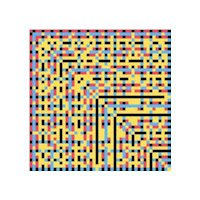A
taxicab number is the smallest integer that is the sum of two positive cubes from
n different sums. So there's one taxicab number for
n = 1, 2, 3. . . A cabtaxi number is the smallest positive integer that is the sum of two positive
or negative integers from
n different sums. (See
Wikipedia or
Wolfram.) Only nine cabtaxi numbers are known, though more are supposed to exist even though they haven't been found yet. All but the first three are seven digits or more. It occurs to me that the numbers for real taxicabs should be just a few digits — more than one, but less than seven certainly. So I think it would be interesting to find all the two, three, or four digit
candidates for cabtaxi numbers (the cabtaxi fleet) , and it shouldn't matter whether they're the smallest integer for
n sums.
Therefore, a
cabtaxi candidate is like a cabtaxi number except that it may not be the
smallest integer; and, for this project I'll say that it should be from 2 to 4 digits. This set of cabtaxi candidates would include Cabtaxi(2) and Cabtaxi(3) — 91, 728 — as well as the taxicab number, 1729, which is Taxicab(2).
Here are a few of the candidates in the cabtaxi fleet, but probably not all:
91 = 63 – 53 = 33 + 43, Cabtaxi(2)
152 = 63 – 43 = 33 + 53189 = 63 – 33 = 43 + 53
217 = 93 – 83 = 63 + 13513 = 93 – 63 = 83 + 13721 = 93 – 23 = 163 – 153
728 = 93 – 13 = 123 – 103 = 63 + 83, Cabtaxi(3)
1027 = 193 – 183 = 103 + 33
1729 = 13 + 123 = 93 + 103, Taxicab(2)
1736 = 183 – 163 = 123 + 233367 = 163 – 93 = 343 – 333
4104 = 183 – 123 = 153 + 93 = 163 + 235824 = 183 – 23 = 243 – 203
5859 = 193 – 103 = 273 – 2437922 = 203 – 23 = 243 – 183
8216 = 383 – 363 = 203 + 63
8587 = 543 – 533 = 193 + 123From this we should be able to develop a way to use cabtaxi candidates graphically, similar to the
coprimes plots.
Two ways to look at Cabtaxi(2):

















